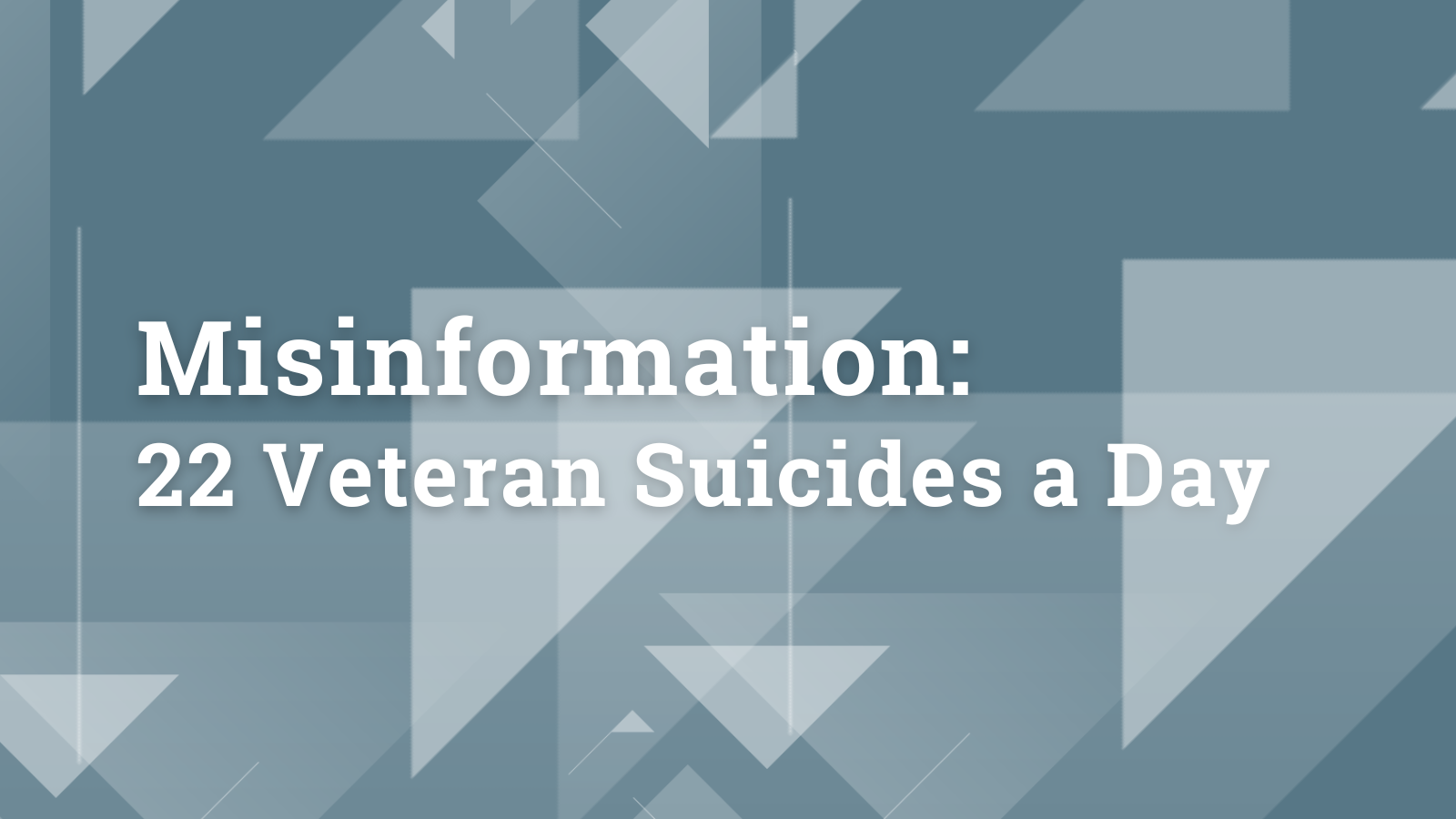In the work I do to support service members, Veterans, and their families (SMVF), I see misinformation daily. A large misconception is that there is an average of 22 Veteran suicides each day. In this blog, I will provide facts and walk you through where the number 22 originated and what the actual numbers are.
Like many of you, I have seen the statistic of 22 Veteran suicides a day all over the place, from posts on social media to quotes from government representatives. So, where did this number come from?
In an effort to look deeper into the Veteran suicide rate, the U.S. Department of Veteran Affairs (VA) compiled the Suicide Data Report, 2012. In this report, the VA analyzed suicide data from 21 states and found that 18.3% of those suicides were identified as having military history. The report also revealed that Veteran status was listed as “unknown” on many death certificates. Utilizing this data, the VA stated that there was an average of 22.2 Veteran suicides a day in 2010 (pg. 15). With this statement, came awareness campaigns or promotions that you may have heard of, such as the 22 pushup challenge or 22Kill Pushup Challenge.
In 2018, VA released the VA National Suicide Data Report 2005–2016. The report included updated information from the National Death Index’s mortality data through 2016 for all 50 states and the District of Columbia. This report did not, however, give an average number of suicides per day (pg. 2). In 2019, VA released the first National Veteran Suicide Prevention Annual Report. In this report, VA explained,
“We note that a prior report indicated that there were on average 20 suicide deaths per day in 2014 when combining three groups who died from suicide: Veterans, current service members, and former National Guard or Reserve members who were never federally activated. This report is specific to Veterans as defined above (Title 38). For this reason, results should not be directly compared with the information presented in previous reports” (pg. 4).
This was the first time they mentioned that the prior statistic had included service members, inactive Guardsmen and Reservists, and Veterans under the title Veteran. As a result, subsequent annual reports always include mention of this. One example is the 2020 National Veteran Suicide Prevention Annual Report (pg. 15, Footnote 46).
Additionally, the 2020 National Veteran Suicide Prevention Annual Report provided updated calculations by year, removing current service members, and never federally activated guard and reserve members. With this adjustment, the average number of Veteran suicides per day in 2010 was actually 17.7 (pg. 16).
The 2022 National Veteran Suicide Prevention Annual Report indicated a decrease in Veteran suicides, with 343 fewer Veteran suicides in 2020 than in 2019; even though the Veteran population increased in 2020 (pg. 6). The average number of Veteran suicides for 2020 is 16.8 a day (pg. 7). Veteran suicides are still occurring at a higher rate than that of non-Veteran U.S. adults (pg. 10; 31.7 per 100,000 Veteran suicides vs. 16.1 per 100,000 civilian suicides in 2020). While, thankfully, the number is not 22 a day, an average of 17 (16.8) Veteran suicides a day is still too many.
Through programs such as the Governor’s and Mayor’s Challenges to Prevent Suicide Among Service Members, Veterans, and their Families and Crisis Intercept Mapping, states, territories, and local communities are working tirelessly to end suicide among SMVF. Below, I have provided links to suicide prevention resources you can use to support SMVF and suicide prevention efforts.
If you or someone you know is having thoughts of suicide, please call 988 for help from the 988 Suicide and Crisis Lifeline, or dial 988 and press 1 for the Veteran Crisis Line.
Resources
- Don’t Wait. Reach Out.: VA Suicide Prevention resource website created for Veterans as well as family members and friends of Veteran.
- Ask the Question Toolkit: New Hampshire’s Ask the Question Toolkit was made for any organization that wants to support SMVF whether in New Hampshire or not.
- VA Social Media Safe Messaging Toolkit: A guide for anyone communicating and writing about Veteran suicide.
- VA Community Care Provider Toolkit: The Community Provider Toolkit is a resource for healthcare professionals working with Veterans outside of the VA health care system.
- AFSP-NSSF Suicide Prevention Toolkit: By participating in the AFSP-NSSF Suicide Prevention Program, you will be connected to a nationwide effort developed by AFSP called Project 2025, which seeks to reduce the annual U.S. suicide rate by 20 percent by the year 2025.
- VA Safe Firearm Storage Toolkit: Suicide prevention is everyone’s business: a toolkit for safe firearm storage in your community.
- CALM: Counseling on Access to Lethal Means: This free online course focuses on how to reduce access to the methods people use to kill themselves. It covers how to: (1) identify people who could benefit from lethal means counseling, (2) ask about their access to lethal methods, and (3) work with them—and their families—to reduce access.
- SMVF Special Populations: Find resources for special populations among service members, Veterans, and their families.


